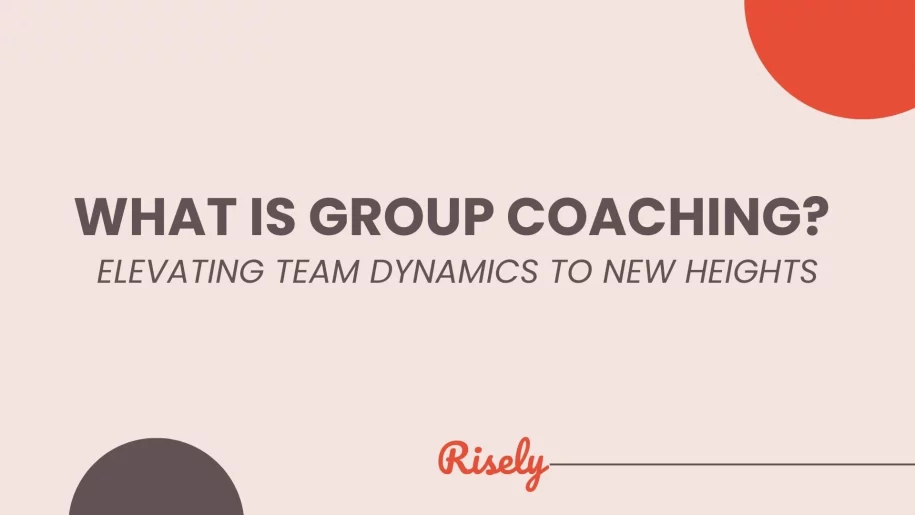What is Group Coaching? Elevating Team Dynamics to New Heights
Traditional training methods often fail to address today’s complex team dynamics and organizational challenges. Group coaching, however, leverages the strength of collective growth within an organizational setting, fostering both your and your team’s development while aligning everyone with organizational goals. This approach not only accelerates progress but also inspires meaningful, lasting change. In this blog, we’ll explore what is group coaching, and how it elevates your team’s performance and transforms organizational culture to create a foundation for success and resilience.What is Group Coaching?
Group coaching is a structured process for fostering personal growth and team success, highlighting the benefits of leadership coaching in a group setting. Led by an experienced coach, group sessions focus on goal-oriented discussions and real-world challenges involving a group of individuals who share common goals. Participants collaborate, problem-solve, and brainstorm together to reach actionable solutions. This approach leverages the power of shared experiences, creating a rich environment where your team members learn from each other’s successes and setbacks. They gain new insights, reinforce accountability, and build a resilient problem-solving culture.The Impact of Group Coaching
Group coaching transforms team dynamics and boosts organizational performance by building a collaborative learning environment:- Accelerated Learning: Your team learns new concepts faster by sharing their experiences and strategies. For instance, one member might share a successful approach to boost team morale that others adopt, speeding up learning across the group.
- Enhanced Accountability: Group coaching fosters a culture where team members support and hold each other accountable for their goals. For instance, a group of managers might set collective objectives to improve team engagement and regularly check in to track progress.
- Improved Team Dynamics: This method helps resolve interpersonal challenges and enhance communication, leading to better collaboration. For instance, a team with conflicting work styles might explore new techniques to work more effectively together, aligning efforts and building cohesion.
Group Coaching vs. Individual Coaching
Understanding the differences between group and individual coaching assists you choose the best approach based on your team’s goals and needs.Group Coaching
Group coaching is designed to enhance team dynamics by fostering collaboration, trust, and collective performance among diverse people. For instance, a cross-functional team comprising marketing, sales, and product development may share a common objective, such as launching an innovative product. However, working in isolation across departments create silos and hinder progress. Group coaching encourages team members to openly share ideas, align priorities, and solve problems together. This process breaks down barriers, builds trust, and strengthens the team’s ability to work cohesively, ultimately improving overall performance and achieving common goals.Individual Coaching
Individual coaching focuses on personal growth and leadership development. It is often used to help individuals refine specific skills, such as strategic thinking or decision-making, and navigate career transitions. For instance, a newly promoted manager may face challenges in leading a team through a significant change. Individual coaching provides tailored guidance, helping the manager develop the skills needed to succeed in their role, such as managing large-scale initiatives, improving communication, and making confident decisions. This one-on-one approach ensures that leadership capabilities are aligned with personal goals and the organization’s needs.Blended Approach
In some cases, a combination of both coaching styles is most effective. Group coaching establishes alignment and collaboration at the beginning of a project or team restructuring. As the project progresses and leadership responsibilities increase, individual coaching is introduced to address more specific developmental needs, such as emotional intelligence or conflict management. This approach ensures that both team cohesion and individual leadership growth are prioritized, offering a holistic solution that enhances both collaboration and leadership effectiveness. By understanding the strengths of each coaching method and how they complement one another, you strategically integrate both to maximize team performance and individual development, ensuring that both the team and the organization achieve long-term success.How to Design an Effective Group Coaching Program?
Designing a successful group coaching program involves structuring it carefully around the following key elements:- Clear and Measurable Goals: Set objectives tailored to your team’s needs.
- Optimal Program Structure: Choose the right group size, session frequency, and duration to keep your team engaged.
- Comprehensive Curriculum Development: Include interactive exercises, group discussions, and hands-on learning to enhance the coaching experience.
- Diverse Learning Styles: Use visual aids, role-playing, and reflective exercises to accommodate different learning preferences.
- Engagement Strategies: Incorporate storytelling and real-world scenarios to make the program relatable and ensure active participation.
How Do You Customize Group Coaching for Your Organization’s Objectives?
Customizing group coaching for your team begins with a clear understanding of your L&D strategy. You need to define the leadership skills and behaviors that will drive success and align directly with your goals. What are the challenges your organization is facing? How does coaching bridge the skill gaps and propel your team toward these objectives? Tailoring the coaching to these needs ensures it remains focused and impactful, targeting areas such as strategic thinking, decision-making, and collaboration across teams. Once the goals are set, it’s crucial to understand your team’s specific needs. Here’s how you customize coaching for your team:- Assess the strengths and weaknesses within your team.
- Identify common pain points or skills gaps.
- Design activities that allow your team to learn from one another’s experiences, accelerating growth.
- Leadership effectiveness and decision-making.
- Enhanced team communication and collaboration.
- Improved employee retention and engagement.
How to Strengthen Leadership Through Group Coaching?
Group coaching is a powerful tool for developing leadership by fostering collaboration, accountability, and personal growth. It allows your team to gain insights not only from a coach but also from their peers. It elevates your team’s leadership development by:Fostering a Collaborative Leadership Culture
Group coaching creates an environment where your team members exchange ideas, challenge assumptions, and gain new perspectives. This enhances critical thinking skills, decision-making, and creativity, strengthening their ability to inspire and guide teams.Providing a Safe Space for Reflection and Growth
Leadership often comes with high pressure, leaving little time for self-reflection. Group coaching offers a structured, safe space for your team to assess their styles and challenges, fostering personal and professional development and nurturing authentic leadership.Developing Emotional Intelligence (EQ)
Group coaching helps your team enhance their emotional intelligence—key to effective leadership. Through peer interactions, they improve their ability to manage emotions, resolve conflicts, and build trust, leading to stronger team dynamics and performance.Creating Opportunities for Peer-to-Peer Learning
One of the greatest strengths of group coaching is peer learning. Your team members share real-world challenges and their solutions, fostering accountability and encouraging risk-taking. This collective learning boosts problem-solving and enhances manager effectiveness.Strengthening Accountability
Group coaching builds a culture of accountability, where your team sets clear goals and holds each other responsible for progress. This drives continuous improvement and pushes leaders to grow beyond their comfort zones, advancing both their skills and organizational objectives.Aligning Leadership Development with Organizational Goals
For group coaching to be effective, it must align with your organization’s objectives. Tailoring coaching to enhance skills like strategic thinking, communication, or teamwork ensures your team’s growth directly contributes to the organization’s success. Incorporating group coaching into your leadership strategy promotes collective growth, making your team more resilient and capable of driving long-term success.How Does Technology Enhance the Group Coaching Experience?
Technology significantly enhances group coaching by offering tools that streamline your team’s collaboration, communication skills, and learning. Virtual platforms like Zoom, along with a dedicated coaching platform for business, make it easy for teams to connect and engage, no matter where they’re located. Risely- an AI Copilot for Leadership Development, is available on platforms like Slack and provides its feature Merlin- the AI Leadership Coach, directly to your team on the platform. Your team gets access to coaching whenever and wherever they want because of such technological advancements. Learning management systems (LMS) also provide a valuable extension to group coaching. A lot of coaches utilize these platforms as they offer additional resources, track individual and team progress, and allow for on-demand learning so that your team gets to revisit content as needed. Elements like Risely’s daily Nudges share actionable tips to your team members to maintain daily progress. Additionally, an online type of program complements programs like these to create a dynamic learning environment, keeping your team engaged long after coaching sessions wrap up. Together, these technologies create a cohesive, flexible coaching experience that encourages lifelong learning and development.Conclusion
Investing in group coaching builds a resilient workforce, promotes collaboration, and aligns teams with a shared vision. This collective growth empowers organizations to face challenges head-on, explore the potential of group coaching to drive consistent performance and secure sustainable success. Group coaching is not just a tool for improvement; it’s a strategic path toward a more adaptable and future-ready coaching business.Do You Wish Your Team Had Access to Coaching 24/7?
Merlin, the AI Leadership Coach, is available whenever and wherever you need him.
How to Build a Leadership Journey? ft. Thomas Ulbrich
Effective leadership doesn’t always begin with a grand vision. Sometimes, it takes root in the courage to take the first…
AI and Leadership Development: Driving Synergy for Growth
AI and Leadership Development: Driving Synergy for Growth You know the frustration all too well. Your organization invests thousands in…
How Are AI Learning Platforms Transforming Leadership Development?
As an L&D leader, you’re likely familiar with this frustrating reality: 82% of organizations consider leadership development critical(1), yet only…
5 Essential AI Skills for L&D Leaders
5 Essential AI Skills for L&D Leaders According to LinkedIn’s 2025 Workplace Learning Report(1), 71% of L&D professionals are now…
How to Create a Course with AI: A Guide for L&D Professionals
How to Create a Course with AI: A Guide for L&D Professionals According to a McKinsey survey(1), only 11% of…


